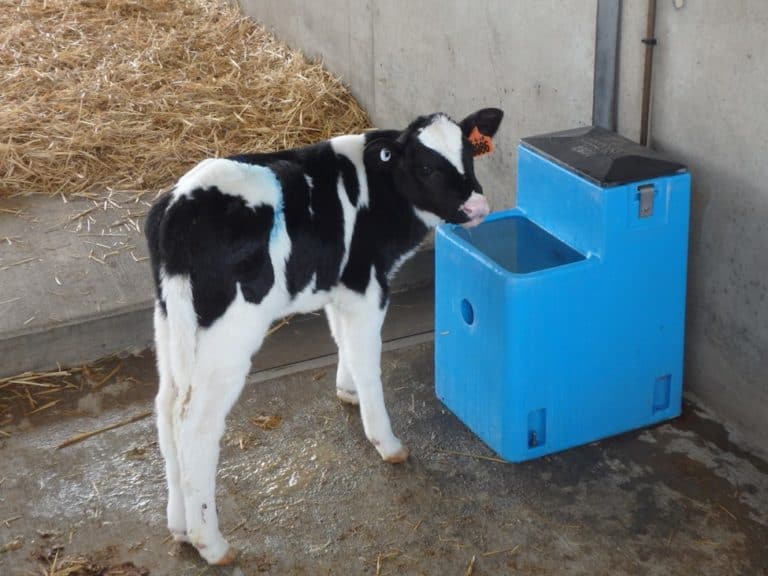Keep it clean!!
Our discussions pertaining to calf management frequently focus on nutrition, milk or milk replacer, colostrum, vaccinations, feed additives……. Rarely do we consider the impact of hygiene on our success in raising calves. For this post, let’s consider the impact of hygiene on calf health and growth.
Calving environment – While in utero the calf resides in a nearly sterile environment. What is the first thing that the calf experiences when it’s born? Is it a clean calving environment or is it “contaminated” with manure, urine…… The latter situation will encourage rapid colonization of the alimentary canal with undesirable microorganisms. Rebedding calving stalls after each calving or pasture calving promotes the colonization of the digestive system with more desirable organisms.
Colostrum – Our focus has been on the delivery of grams of IgG. However, research by James et al (1978) and Godden et al () note that the bacteria count of colostrum also has a significant impact on the efficiency of IgG absorption by the intestine of the newborn. Special care should be taken to ensure that the first feeding of colostrum contains less than 50,000 cfu/ml. Field research has shown that this is readily achieved by feeding soon after collection from the dam, prompt cooling before storage or heat treatment prior to feeding in clean device.
Feeding management – How we feed the liquid diet has a significant impact on hygiene and health of the preweaned calf.
- Buckets are rarely cleaned and sanitized after each feeding, leaving significant biofilms which foster bacterial growth between feedings. When the same bucket is used for feeding water, bacterial growth will be excessive.
- Bottles are usually cleaned between feedings but are usually cleaned by using a pressure washer by one of the calf feeding team members. This is labor intensive and is dependent upon the diligence of the person assigned this task. Automated systems are available and usually are more successful in effectively cleaning and sanitizing the bottles.
- Nipples are more difficult to clean and can be a source of bacterial growth, particularly if they are not replaced when they become worn and develop cracks and tears.

Replace nipples when they begin to show cracking as shown in this picture.
Autofeeders – Advancements in sanitizing technology have been made over the last few years that enhance the capabilities of the feeder to maintain hygiene.
- Older machines “cleaned” milk contact surfaces using a detergent formulated for peak effectiveness at the lower temperatures associated with feeding temperatures. There were two phases involved:
- Automatic cleaning of the mixer and heat exchanger can be scheduled at times fixed by the user. Virginia Tech field research indicated that 3 to 4 times daily is optimal. In addition, hose rinsing can be programmed which allows the calf to drink 250 ml of water after each meal.
- Manual cleaning is initiated by the calf team member which in addition to cleaning the mixer and heat exchanger that hoses are cleaned. This requires the user to disconnect the nipple and place the milk hose into the mixer prior to initiating the cleaning cycler. Currently, it is recommended to manually clean and inspect the nipples prior to reattaching them at the end of the circuit cleaning process.
- Dedicated calf managers will also manually clean the feeding station area.

Manual cleaning of the feeder stall with detergent and hot water rinse is strongly recommended.
- If you have an older machine that only has one pump, it is recommended to use acid sanitizer instead of detergent one or two times per week.
- Regardless of the age of the system, it is recommended to manually clean the nipples and replace them when showing signs of wear.
- For systems using milk rather than milk powder, a sponge can be inserted during the cleaning process which cleans the heat exchanger coil.
- Newer machines have two pumps which enable cleaning of the system with a detergent followed by the circulation of a sanitizing agent.

Autofeeder with containers for detergent and acid sanitizing on newer equipment with two cleaning pumps.
- Foerster Technik is pleased to announce the development of the “hygiene box” which enables automated cleaning and sanitizing of nearly all milk contact surfaces. This feature is described on the Foerster Technik website. https://www.foerster-technik.de/kaelberfuetterung/traenkeautomat-zubehoer/hygienebox/

- Even with Hygiene box still recommend rotating nipples daily clean let dry and use the next day.
- The success of any automated cleaning system requires the use of the correct detergents and sanitizer formulated for the autofeeder to assure correct concentrations and the operating temperatures found in autofeeders. In addition, it is strongly recommended that water quality be evaluated for hardness, mineral content and any other items of concern (bacteria, nitrates….)
The importance of hygiene in feeding calves has been ignored or occupies a lower priority in calf management. Milk or milk replacer is an excellent growth medium for bacteria harmful to the calf. One can provide adequate levels of high-quality nutrients, but if undesirable bacterial growth is excessive the calf the incidence of scours and other diseases can become excessive. Virginia Tech research has found that scheduling at least three mixer / heat exchanger cleanings and one manually conducted circuit cleaning and manual cleaning of the nipple were effective management tools in minimizing microbial growth in the diet.
For further details on the cleaning features of the automated feeder consult the Quick Start Guide section of the calfblog.com website. https://calfblog.foerster-technik.com/quick-start-guides-fur-the-forster-technik-automatic-feeder-system/

Good Hygiene also means cleaning automatic waterers for calves daily.

